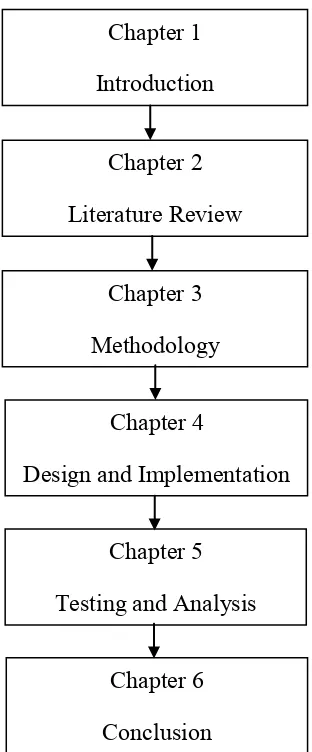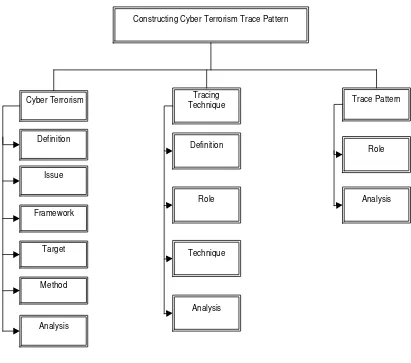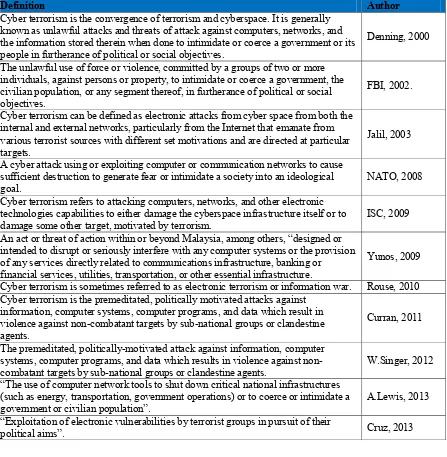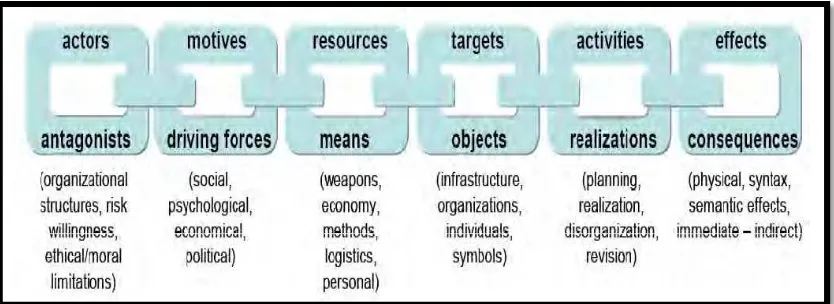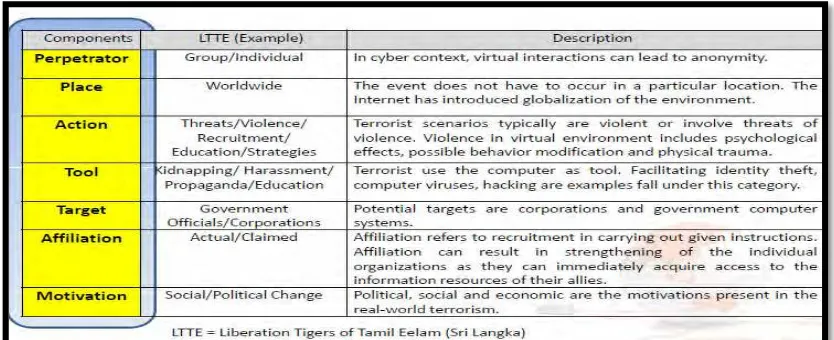CONSTRUCTING CYBER TERRORISM TRACE PATTERN
NURHASHIKIN BINTI MOHD SALLEH
FACULTY OF INFORMATION AND COMMUNICATION TECHNOLOGY UNIVERSITI TEKNIKAL MALAYSIA MELAKA
i
Acknowledgement
Bismillahirrahmanirrahim
Alhamdulillah, Thanks to Allah SWT, whom with His willing give me the opportunity to complete this Final Year Project which is title Constructing Cyber Terrorism Trace Pattern. This final year project report was prepared for Faculty of Information and Communication Technology (FTMK), Universiti Teknikal Malaysia Melaka (UTeM), basically for student in final year to complete the undergraduate program that leads to the degree of Bachelor of Computer Science.
First of all, I would like to express my very great appreciation to Dr. Siti Rahayu, a lecturer at FTMK, UTeM and also assign as my supervisor who had guide and give useful critiques for this project work. I also would like to thanks to Dr. Siti Rahayu for the advice and assistance in keeping my progress on schedule.
ii
Abstract
iii
Abstrak
iv
Dedication
Dedicated to all my family: Thank you for all you love
v 1.1 Background Study ... 1
1.2 Problem Statement ... 3
1.3 Project Questions ... 3
1.4 Project Objective ... 4
1.5 Project Scope ... 4
1.6 Expected Output ... 4
1.7 Report Organization ... 4
1.8 Summary ... 6
CHAPTER 2 LITERATURE REVIEW
2.1 Introduction ... 72.2 Cyber Terrorism ... 8
2.2.1 Definition of Cyber Terrorism... 8
2.2.2 Issue on Cyber Terrorism ... 9
2.2.3 Framework of Cyber Terrorism... 10
2.2.4 Targets of Cyber Terrorism ... 13
2.2.5 Methods of Cyber Terrorism ... 14
2.2.6 Analysis on Cyber Terrorism ... 15
vi
2.3.1 Definition of tracing technique ... 15
2.3.2 Role of tracing technique... 15
2.3.3 Technique for trace data ... 15
2.3.4 Analysis on tracing technique ... 17
2.4 Trace pattern... 17
2.4.1 Role of trace pattern ... 17
2.4.2 Analysis on trace pattern ... 18
2.5 Summary ... 18
CHAPTER 3 METHODOLOGY
3.1 Introduction ... 203.2 Project Methodology ... 20
3.2.1 Planning Phase... 21
3.2.2 Analysis Phase ... 21
3.2.3 Design and Implementation Phase ... 21
3.2.4 Testing Phase ... 21
3.2.5 Maintenance Phase ... 21
3.3 Project Tools and Project Requirement... 22
3.4 Project Schedule and Milestones ... 22
3.4.1 Gantt chart ... 22
3.4.2 Milestones... 23
3.5 Summary ... 24
CHAPTER 4 DESIGN AND IMPLEMENTATION
4.1 Introduction ... 254.2 Analysis Design ... 25
4.2.1 Classifying and Extraction Data Phase... 25
4.2.2 Mapping Data Phase ... 26
4.2.3 Generate Trace Pattern Phase ... 27
4.3 Analysis and Finding Data ... 28
4.3.1 Analysis and Finding for DS1 ... 29
vii
4.3.3 Analysis and Finding for DS3 ... 44
4.3.4 Overall Analysis of Findings ... 49
4.4 Implementation ... 51
4.4.1 Classifying and Extraction Data Algorithm ... 51
4.4.2 Mapping Data Algorithm ... 52
4.4.3 Generate Trace Pattern Algorithm... 52
4.5 Summary ... 53
CHAPTER 5 TESTING AND ANALYSIS
5.1 Introduction ... 545.2 Test Plan ... 54
5.2.1 Test Organization ... 54
5.2.2 Test Environment ... 54
5.3 Test Strategy... 56
5.6.1 Analysis of Result Testing... 63
5.6.2 Discussion of Result Testing ... 66
5.6.3 General Cyber Terrorism Trace Pattern ... 67
5.7 Summary ... 68
CHAPTER 6 CONCLUSION
6.1 Introduction ... 696.2 Project Summarization ... 69
6.3 Contributions ... 70
6.4 Observation on strengths ... 70
viii
6.6 Future Work ... 71
REFERENCES ... 72
APPENDIXES ... 75
Appendix A- Sample of script ... 75
ix
LIST OF TABLES
Table Title Page
1.1 Comparison of number of incidents between January-Jun 2012 and
January-Jun 2013... 1
1.2 Project problem... 3
1.3 Project question... 3
1.4 Project objective... 4
2.1 Definition of cyber terorism... 8
2.2 10 riskiest countries... 10
2.3 Cyber terrorism components... 13
2.4 List of types of keyword... 16
2.5 List of types of website... 17
3.1 Project gantt chart... 22
3.2 PSM milestones... 23
4.1 Description of dataset... 28
4.2 Classification of keyword and website... 29
4.3 List of keyword with its type... 32
4.4 Website with its type... 34
4.5 Components with its description... 34
4.6 Traces mapping with cyber terrorism components... 36
4.7 Classifying of keyword with its type... 40
4.8 Classifying of website with its type... 41
4.9 Traces mapping with the components of cyber terrorism... 42
4.10 Classifying of keyword with its type... 45
4.11 Classifying of website with its type... 46
4.12 Traces mapping with the components of cyber terrorism... 47
4.13 Overall analysis of cyber terrorism traces... 49
5.1 Hardware requirements... 55
5.2 Software requirements... 55
5.3 Dataset description... 57
5.4 List of keyword related to cyber terrorism... 59
x
xi
LIST OF FIGURES
Figure Title Page
1.1 Flow of report organization... 5
2.1 Framework of literature review... 7
2.2 Cyber terrorism framework (Heickero)... 10
2.3 Cyber terrorism framework (Gordon)... 11
2.4 Cyber terrorism framework (Yunos)... 12
3.1 Cyber terorism phase... 20
4.1 Analysis design of trace pattern... 25
4.2 Process flow of classifying and extraction data... 26
4.3 Process flow of mapping data... 27
4.4 Process flow of generating trace pattern... 28
4.5 Process flow of classifying and extraction traces into types of keyword... 30
4.6 Example of traces for keyword... 31
4.7 Process flow of classifying and extraction traces into types of website... 33
4.8 Example of traces for website... 33
4.9 Process flow of mapping classification keyword... 35
4.10 Cyber terrorism trace pattern for DS1... 38
4.11 Example of traces for keyword... 39
4.12 Example of traces for website... 41
4.13 Cyber terrorism trace pattern for DS2... 43
4.14 Example of traces for keyword... 44
4.15 Example of traces for website... 46
4.16 Cyber terrorism trace pattern for DS3... 48
4.17 Cyber terorism schema... 50
4.18 Pseudo code of classifying and extraction data... 51
4.19 Pseudocode of mapping data... 52
xii
5.1 Test environment design... 56
5.2 The result of traces keyword... 58
5.3 Result of cyber terrorism trace pattern for DS1... 59
5.4 The result of traces for keyword... 60
5.5 Result of cyber terrorism trace pattern for DS2... 61
5.6 The result of traces for keyword... 62
5.7 Result of cyber terrorism trace pattern for DS3... 63
5.8 Overall result for dataset... 64
1
CHAPTER I
INTRODUCTION
1.1 Background Study
Cyberspace was first introduced in science fiction and cinema since in the 1980s. It was adopted by computer professionals and became a household term in the 1990s. In terms of definition, cyberspace is the electronic medium of computer networks, in which online communication takes place (American Heritage, 2010). The term is used to refer to objects and identities that exist largely within the communication network it. Cyberspace is which online relationships and alternative forms of online identify were enacted. It does not have a standard or objective definition such other computer terms. It can be clarified as a virtual of computers.
Nowadays, cyber terrorism has become serious issue and increase sophisticated. It is because the threat of cyber terrorism and the misuse of the Internet for terrorist purposes are particularly alarming because our society is dependent on computer systems and the Internet. It is reported that the number of crimes involving computers and internet has grown up (Selamat, 2011).
Table1.1: The comparison of number of incidents between January-Jun 2012 and January-Jun 2013 (Cyber Security Malaysia, 2013).
2
Based on the Table 1.1, it shows that from January to June 2013, a total of 5,592 cyber security incidents compared to 5,581 incidents reported in first half of 2012. Fraud is the most-reported incidents followed by intrusion, spam, malicious code, cyber harassment, content related, intrusion attempts, Denial of Service (DoS), and vulnerability reports.
In term of cyber terrorism definition, most government in the world cannot agree on one single definition for terrorism. The part of the problem is in defining cyber terrorism as there are broadly different definitions as to what actually constitutes cyber terrorism (Yunos, 2009). Cyber terrorism is the use of Internet based attacks in terrorist activities, including acts of deliberate, large-scale disruption of computer networks, especially of personal computers attached to the Internet, by the means of tools such as computer viruses, hacking (Ali Fahad, 2012). It also can be defined as the intentional use of computer, networks, and public internet to cause destruction and harm for personal objectives.
3
By analyse the cyber terrorism behaviour; cyber terrorism can be identified based on data found in trace pattern analysis. Trace pattern is defined as a regular way of process discovering the origin or starting point of a scenario that has happened (Selamat et. al, 2011). It is very difficult to trace the cyber terrorists because there are no specific trace patterns about it. By construct the trace pattern, it will help the investigator in finding evidence about cyber terrorism. By doing the tracing technique, it will able to discover the traces left in digital devices. Trace pattern will provide the clear view on how the cyber terrorism occurs.
1.2 Problem Statement
The number of crime in cyber terrorism has been increase. It is too difficult to trace the cyber terrorism because there is no trace pattern about it. By using the tracing technique, it can help the investigator to discover the cyber terrorism. The trace pattern to provide the evidence.
1.3 Project Questions
Based on the problem statements, three project questions (PQ) are constructed as shown in Table 1.3.
Table 1.3: Project Question
PP PQ Project Question (PQ)
PP1 PQ1 What is the analysis technique can do to overcome the cyber terrorism?
PQ2 How could we identify the cyber terrorism?
4
1.4 Project Objective
In order to solve the problem identified as in Section 1.2, three project objectives (PO) are derived as shown in Table 1.4.
Table 1.4: Project Objective PP PQ PO Project Objective (PO)
PP1 PQ1 PO1 To study and identify cyber terrorism activities. PQ2 PO2 To analyze the cyber terrorism behavior.
PQ3 PO3 To formulate the cyber terrorism trace pattern.
1.5 Project Scope
The scope for this project are:
1. This project analyse the cyber terrorism behavior based on the components of cyber terrorism that consists of actors, motivation, tools, method, target, and impact.
2. By knowing the cyber terrorism behavior, create a tracing technique to discover the trace pattern of the cyber terrorism.
3. The data used in this project is limited to the potential cyber terrorist websites.
1.6 Expected Output
The expectation by the end of this project is to contribute and provide a better trace pattern of cyber terrorism, which may lead to the effective strategy to counter cyber terrorists and gain more theoretical knowledge practical of cyber terrorism.
1.7 Report Organization
5
Figure 1.1: Flow of report organization.
Figure 1.1 shows the flow of report organization for this project. The explanation for each chapter will be elaborate below.
Chapter One: Introduction
This chapter explained about the definition, background, problem statement, objective, scope and expected output related to the cyber terrorism.
Chapter Two: Literature review
This chapter explained about cyber terrorism, tracing technique, and trace pattern. It will help to more understanding about what is the constructing cyber terrorism trace pattern.
Chapter 1 Introduction
Chapter 2 Literature Review
Chapter 3 Methodology
Chapter 4
Design and Implementation
Chapter 5 Testing and Analysis
6
Chapter Three: Methodology
This chapter provide a decision of the method or what analysis techniques to be used for experimental part. With the certain analysis technique, it helps to know about the cyber terrorism behaviour. It also will involve about the trace pattern of cyber terrorism based on the framework.
Chapter Four: Design and Implementation
The design of tracing technique is describe in details on how it works carried out. The sample of result and output will be providing.
Chapter Five: Testing and analysis
On the testing and analysis part, it explains about the method use and procedure on how to test and analyse the experiment. After the tracing technique was obtained, we compare the result with the trace pattern of cyber terrorism.
Chapter Six: Conclusion
This chapter compile the entire chapter in a final documentation and state the contribution that able to provide for future works.
1.8 Summary
7
CHAPTER II
LITERATURE REVIEW
2.1 Introduction
The previous chapter has been discussed the problem statement, objectives and the scope of this project. In this chapter, it will explain about the related topics as shown in Figure 2.1. The literature is based on the several resources such as journal articles, proceeding, technical reports and white paper.
Constructing Cyber Terrorism Trace Pattern
Figure 2.1: Framework of literature review
8
2.2 Cyber Terrorism
In this section, the definition, problem related, framework, targets, methods, tools, and trace of cyber terrorism are elaborated and analysed.
2.2.1 Definition of Cyber Terrorism
The term cyber terrorism is becoming increasingly common nowadays, yet a solid definition for it and what it constitutes is subjective and covers a wide area. There are several definitions by different authors on what is actually means by cyber terrorism as shown in Table 2.1.
Table 2.1: Definition of Cyber terrorism.
Definition Author
Cyber terrorism is the convergence of terrorism and cyberspace. It is generally known as unlawful attacks and threats of attack against computers, networks, and the information stored therein when done to intimidate or coerce a government or its people in furtherance of political or social objectives.
Denning, 2000
The unlawful use of force or violence, committed by a groups of two or more individuals, against persons or property, to intimidate or coerce a government, the civilian population, or any segment thereof, in furtherance of political or social objectives.
FBI, 2002.
Cyber terrorism can be defined as electronic attacks from cyber space from both the internal and external networks, particularly from the Internet that emanate from various terrorist sources with different set motivations and are directed at particular targets.
Jalil, 2003
A cyber attack using or exploiting computer or communication networks to cause sufficient destruction to generate fear or intimidate a society into an ideological
goal. NATO, 2008
Cyber terrorism refers to attacking computers, networks, and other electronic technologies capabilities to either damage the cyberspace infrastructure itself or to
damage some other target, motivated by terrorism. ISC, 2009
An act or threat of action within or beyond Malaysia, among others, “designed or intended to disrupt or seriously interfere with any computer systems or the provision of any services directly related to communications infrastructure, banking or financial services, utilities, transportation, or other essential infrastructure.
Yunos, 2009
Cyber terrorism is sometimes referred to as electronic terrorism or information war. Rouse, 2010 Cyber terrorism is the premeditated, politically motivated attacks against
information, computer systems, computer programs, and data which result in violence against non-combatant targets by sub-national groups or clandestine agents.
Curran, 2011
The premeditated, politically-motivated attack against information, computer systems, computer programs, and data which results in violence against
non-combatant targets by sub-national groups or clandestine agents. W.Singer, 2012
“The use of computer network tools to shut down critical national infrastructures (such as energy, transportation, government operations) or to coerce or intimidate a
government or civilian population”. A.Lewis, 2013
“Exploitation of electronic vulnerabilities by terrorist groups in pursuit of their
9
Table 2.1 shows the several definitions by different authors; we can conclude that there are differing opinions as to what actually is cyber terrorism. This project defines cyber terrorism as the use of Internet to launch any attacks in terrorist activities such as against computer system, computer program, or data which result on damage cyber space infrastructure itself or some other target. It can be both internal and external networks.
2.2.2 Issue on Cyber Terrorism
Nowadays, the issue on the cyber terrorism has become serious due to the increase of number cases on cyber crime. As we know that with Internet, it can provide connection between computers, sharing any information or news, and be able to communicate with people even do it far away from us. Internet has become one of the most important tools because cyber terrorists will use Internet or cyber space as a medium to launch any attack on their target.
Cyber terrorists usually attacks by distributed denial of service attacks, hate websites and hate emails, and attacks on sensitive computer networks (Alisha, 2010). Cyber terrorists may also use Internet as the medium for hacking, spreading negative propaganda, and promoting extreme activities. They also includes warfare attacks against a nation’s state and forcing ICT infrastructure and assets to be fail or destroy. Cyber terrorists use to obtain inside access to networks and systems. These types of attack actually are more dangerous because it is extremely difficult to detect or trace them.
10
Table 2.2: 10 riskiest countries (CyberSecurity Malaysia, 2013).
Figure 2.2 shows Malaysia is the sixth most vulnerable country in the world to cyber crime, in the form of malware attacks through the computer or smart phone. From the table, Malaysia have highest riskiest compared to India, Mexico, UAE, Taiwan, and Hong Kong.
2.2.3 Framework of Cyber Terrorism
There are several of frameworks of cyber terrorism proposed since today. However, the most familiar are the frameworks proposed by Heickero (2007), Gordon and Ford (2002), and Yunus (2012).
a-Heickero (Actor-target-effect Chain)
Heickero introduced his framework known as Actor-target-effect Chain in order to know about the cyber terrorism behaviour as shown in Figure 2.2.
Figure 2.2: Cyber terrorism framework (Heickero, 2007). No. Country Percentage of cyber crime reported (%)
1. Indonesia 23.54
2. China 21.26
3. Thailand 20.78
4. Philippines 19.81
5. Malaysia 17.44
6. India 15.88
7. Mexico 15.66
8. UAE 13.67
9. Taiwan 12.66
11
Figure 2.2 shows the details about the cyber terrorism framework which are consist of actors, motives, resources, targets, activities, and effects. Actor might be organizational structures, risk willingness, and ethical or moral limitations. The motives of cyber terrorism can be social, psychological, economical, and political. The cyber terrorist resources are weapon, economy, methods, logistics, or personal. The cyber terrorism targets might be infrastructure, realization, disorganization, or revision. The effects of cyber terrorism might be in terms of physical, syntax, or sematic attacks. It could be immediate or indirect effects.
b-Gordon and Ford
Gordon introduced his framework in order to know the cyber terrorism behaviour as shown in Figure 2.3.
Figure 2.3: Cyber terrorism framework (Gordon, 2002).


